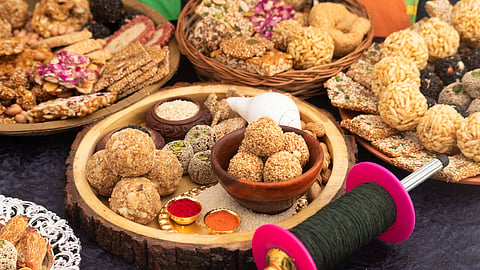
- Destinations
- Experiences
- Stay
- What's new
- Celebrating People
- Responsible Tourism
- CampaignsCampaigns
- SubscribeSubscribe
- Buy Now

Magh Bihu, also known as Bhogali Bihu or Maghar Domahi, is a significant and jubilant festival celebrated in the northeastern Indian state of Assam. This harvest festival is celebrated with great enthusiasm and traditional fervour, marking the end of the harvesting season. A bonfire, known as Meji, is lit for the ceremonial conclusion and prayer to the God of Fire. Rooted in the agrarian culture of Assam, Magh Bihu not only celebrates the abundance of the harvest but also reflects the rich cultural heritage and unity of the people.
As the time for Magh Bihu 2024 approaches, it's essential to learn more about it so that you can plan accordingly and partake in the festivities to the fullest.
The Magh Bihu festival originated as an agricultural celebration that marked the conclusion of the harvesting season. The festival dates back to the time of the Ahom kings, who ruled the region and encouraged agriculture as a crucial aspect of the state's economy. According to Hindu scriptures, the festival dates back to 3500 BC. Scholars speculate that the tradition of Bihu dates back even further to ancient times when people made fire sacrifices for better harvests. The custom of lighting a bonfire on Uruka and burning Meji can be traced back to the fire worship tradition of the agrarian society. The festival has its roots in the customs and rituals practised by the indigenous communities of Assam. During the festival, gratitude is expressed towards the deities for a bountiful harvest, and blessings are sought for the upcoming agricultural cycle.
While Magh Bihu, like many other harvest festivals celebrated across the Indian subcontinent, lasts for seven days, it has some unique customs and traditions of its own. A key custom of the festivals is the building of Meji. It is a makeshift structure made of bamboo, thatch, and local raw materials. The Meji is set ablaze on the night of Magh Bihu to symbolise the burning away of the old and the making of the new. While the faithful pray to the Fire God, people also indulge in a plethora of games such as cockfights, buffalo races, nightingale contests, and egg throwing.
Like many other festivals, Magh Bihu also includes huge community feasts where families and neighbourhoods come together to prepare traditional Assamese delicacies and celebrate. The cuisines include pitha (rice cakes), laru (sesame and jaggery sweets), and much more. The days of the festivals witness many vibrant cultural events like traditional Bihu dance and music performances. Bihu geet is sung and danced to in the spirit of the newness of Magh Bihu.
Magh Bihu is a seven-day festival which begins with Bhogali Uruka, where families come together to feast and build Meji structures. On the central day, Magh Bihu, people light the Meji to symbolise the renewal of the agricultural cycle. Prayers, cultural performances, and festive activities accompany this. Up next, Goru Bihu is dedicated to honouring cattle, who play an important role in farming, while Manuh Bihu emphasises social bonds and mutual greetings. Following that, Kutum Bihu involves seeking blessings from elders, and Mela Bihu engages in cultural events and fairs. Chera Bihu marks the end of the celebration, where the Meji is dismantled, and its ashes are scattered as fertiliser in the fields. These seven days of Magh Bihu celebrate a holistic blend of religious, social, and cultural elements while fostering unity and gratitude among the people of Assam.
In 2024, Magh Bihu begins on January 14. You can head to Assam, where the festival is seen in full glory across its length and breadth. It can be best enjoyed in vibrant cultural hubs such as Guwahati, the largest city in the region, where you can witness Bihu dance, music, and cultural events. Jorhat, the cultural capital, also hosts Bihu competitions and community feasts. Tezpur, with its historical significance, provides an authentic setting for traditional celebrations, while Sivasagar, the ancient capital, adds a historical dimension to the festivities. Dibrugarh's tea gardens and Majuli, the world's largest river island, offer unique settings for cultural richness amidst natural beauty. Additionally, Barpeta, with its renowned Barpeta Satra, is a significant centre for Bihu celebrations.
